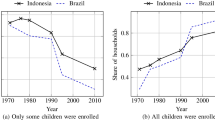Abstract
This study employs an overlapping-generations model featuring public and private education to analyze whether providing child allowances and free high school education influences economic growth. Earlier studies that analyze public and private education (Glomm and Ravikumar, 1992; Cardak, 2004) do not consider models in which fertility is endogenous and individuals can simultaneously choose both public and private education. Earlier studies that consider the effect of child allowances on fertility (Groezen, Leers, and Mejidam, 2003) disregard human capital accumulation. This study assumes people can choose both public and private education simultaneously in a model in which both fertility and human capital accumulation are endogenous. It introduces both child allowances and investment in public education financed by income taxes. It further considers how raising child allowances or investing in public education affects fertility, human capital accumulation, and economic growth. This study is motivated by evidence that the burden of meeting children’s educational expenses is one reason for Japan’s declining birthrate. It analyzes whether child allowances or free high school education can increase the birthrate and promote human capital formation. We find that such policies are unlikely to promote economic growth if they are financed by income taxes that cannot be increased indefinitely.
Similar content being viewed by others
References
Benabou, R. (1996). Heterogeneity, Stratification, and Growth: Macroeconomic Implications of Community Structure and School Finance. American Economic Review, 86: 584–609.
Bental, B. (1989). The Old Age Security Hypothesis and Optimal Population Growth. Journal of Population Economics, 1: 285–301.
Cabinet Office. (2013). Declining Birthrate White Paper in Japanese. http://www8.cao.ao.jp/shoushi/shoushika/whitepaper/measures/w2013/25pdfhonpen/pdf/s1-2.pdf
Cardak, B.A. (2004a). Education Choice, Endogenous Growth and Income Distribution. Economica, 71: 57–81.
Cardak, B.A. (2004b). Education Choice, Neoclassical Growth, and Class Structure. Oxford Economic Papers, 56: 643–666.
Eckstein, Z. and K. Wolpin. (1985). Endogenous Fertility and Optimal Population Size. Journal of Public Economics, 27: 93–106.
Eckstein, Z. and I. Zilcha. (1994). The Effects of Compulsory Schooling on Growth, Income Distribution and Welfare. Journal of Public Economics, 54: 339–359.
Glomm, G. and B. Ravikumar. (1992). Public versus Private Investment in Human Capital: Endogenous Growth and Income Inequality. Journal of Political Economy, 100: 818–834.
Gradstein, M. and M. Justman. (1997). Democratic Choice of an Education System: Implications for Growth and Income Distribution. Journal of Economic Growth, 2: 169–183.
Groezen, B. van, T. Leers, and L. Mejidam. (2003). Social Security and Endogenous Fertility: Pensions and Child Allowances as Siamese Twins, Journal of Public Economics, 87:233–251.
Kaganovich, M. and I. Zilcha. (1999). Education, Social Security, and Growth. Journal of Public Economics, 71: 289–309.
Saint, P.G. and T. Verdier. (1993). Education, Democracy and Growth. Journal of Development Economics, 42: 399–407.
Acknowledgement
An earlier version of this paper was presented at the 15th JEPA International Conference at Onuma International Seminar House, Hokkaido, Japan. I thank Professor Kazuhiro Yaguchi of Tohoku Bunka Gakuen University and Associate Professor Shumpei Yaoita of Shukutoku University for helpful comments on earlier version of this paper. Remaining errors are my responsibility.
Author information
Authors and Affiliations
Corresponding author
Rights and permissions
About this article
Cite this article
Murata, K. Education Policies, Human Capital Accumulation, and Economic Growth. IJEPS 12, 96–106 (2017). https://doi.org/10.1007/BF03405770
Published:
Issue Date:
DOI: https://doi.org/10.1007/BF03405770




